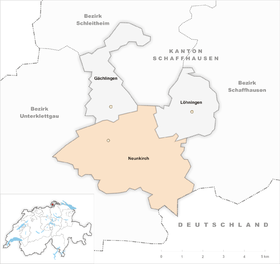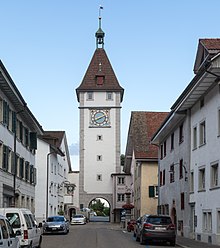Neunkirch
| Neunkirch | |
|---|---|
| State : |
|
| Canton : |
|
| District : | Oberklettgau |
| BFS no. : | 2904 |
| Postal code : | 8213 |
| Coordinates : | 679 621 / 282722 |
| Height : | 429 m above sea level M. |
| Height range : | 393–662 m above sea level M. |
| Area : | 17.92 km² |
| Residents: | 2289 (December 31, 2018) |
| Population density : | 128 inhabitants per km² |
| Website: | www.neunkirch.ch |
| Location of the municipality | |
Neunkirch is a municipality in the canton of Schaffhausen in Switzerland .
geography
The country town of Neunkirch is located in the Klettgau , about 13 km from Schaffhausen . Mayor is Ruedi Vögele ( SVP ).
The border between Germany and Switzerland runs in the southeast .
history

Neunkirch is mentioned for the first time as the location of a deed of gift to the Rheinau monastery . This happened on September 21, a Sunday when Antwarth was Abbot and Ludwig was King. The exact year is not given. The term of office of Abbot Antwarth is not known. However, during the reign of King Ludwig the German (843–876), September 21st fell on a Sunday only in the years 850, 861, 867 and 872.
You don't learn more than the name from the certificate . Not until 1122 is a Vogt mentioned in Neunkirch and in 1155 the Bishop of Constance owned the church and a courtyard. But who the city lords were at this early time is not known today. Presumably it was a noble family who called themselves de Niuchilchun . This sex can be traced back to the end of the 13th century. However, at that time they were no longer the city lords, because when Bishop Eberhard II von Waldburg acquired the high and low jurisdiction and two large courts in 1260 , he bought them from the barons of Krenkingen .
A short time later Neunkirch was destroyed. It is not known whether this was caused by a fire or by enemy troops. However, Neunkirch was rebuilt according to plan after the destruction. A fortified village was created with four straight streets. This historic town center can still be seen today. In the time of the re-establishment, the appointment to the city must have happened. Neunkirch was founded as a center. However, it was never able to take on this function as it was possible, as it was suppressed from the beginning by the nearby city of Schaffhausen . Neunkirch was forbidden from the usual city rights such as market and coinage rights . This prevented Neunkirch from growing in later years.
Neunkirch's fortifications were built for a reason. In 1440 enemy troops invaded the Klettgau and plundered Neunkirch. A short time later, the Bishop of Constance concluded an alliance with the Confederates, whereupon Neunkirch came under this protection. In the Swabian War of 1499, Zurich troops occupied Neunkirch, as Neunkirch was subordinate to the Bishop of Constance, who sympathized with the Swabians. In the further course of the war Neunkirch was spared.
In 1525 the rule of the Bishops of Constance over Neunkirch finally ended. Increased pressure due to the Reformation and the founding of an Anabaptist community in Waldshut , the highly indebted Diocese of Neunkirch sold to Schaffhausen for 8500 guilders. From that day on, the city of Schaffhausen provided the bailiffs in Neunkirch, who resided in Neunkirch Castle. For the population, however, little has changed. During the Thirty Years' War , Neunkirch was spared armed conflicts, but suffered from high inflation and the plague that killed 300 people. It narrowly escaped looting in October 1633 when imperial troops marched down the Wutach valley. The cavalry looted Beggingen , Schleitheim and Hallau , Oberhallau , Siblingen , Trasadingen and Wilchingen .
Not much changed in Neunkirch over the next 150 years or so. The development of the economy was suppressed by Schaffhausen and the citizens were burdened with high taxes. In addition, nepotism flourished, which made it impossible for the lower citizens to take action against injustices on the part of the governors. Although the peasants were unable to study, the ideas of the Enlightenment about rice walkers and journeymen on wandering nevertheless reached the consciousness of the Neunkircher. The citizens tried to improve their lot with several petitions to the Schaffhausen Council, but were rejected in most cases. An important change that was allowed was that Neunkirch was given the right to hold a market twice a year from 1795. Another change that affected the entire canton was the free abolition of serfdom in 1797.
Triggered by Napoleon's victories, unrest broke out across Switzerland in 1798, calling for a change and the abolition of the form of government at that time. In Neunkirch, this happened in February 1799. On the 1st of this month, members of the 22 Schaffhausen parishes met in the Neunkircher parish hall to compose a memorial with the desire for the landscape. In it they called for equality between town and country and an assembly with one freely elected representative for every 50 citizens to draw up a new constitution. Thereupon representatives of the community and city in Neunkirch gathered. The Schaffhausen MPs proclaimed the equality of town and country, but declared that only 12 citizens of each country and town should come together to draft the constitution. When this became known, hundreds of citizens stormed the hall and were only persuaded to leave when they were promised that the city's representatives would stand up for the request. The next day the answer came from Schaffhausen, which met all the wishes of the landscape.


Surname
Neunkirch was first mentioned in the 9th century as Niuchilchun . Niu means “new” and Chilchun “church”, together: “new church”. In the course of the history of the place this name changed. It was called Nuinchilchen , Niunchilchen and Nüwenkilch . In the 17th century it was called Nükilch and Nünkilch .
Over the years, spellings with and without "n" changed. It is believed that the place Neunkirch was written to avoid confusion with other places called Neukirch in the Diocese of Constance .
coat of arms
Blazon :
- In blue and white church with flank tower and red roofs.
The coat of arms of the community Neunkirch was determined from the beginning and exclusively by its name. Proven since 1433 the "new church" forms the emblem of the village. Over time, the appearance of the church on the coat of arms changed, presumably in accordance with the appearance of the church at that time. For example, two or even three towers can be seen in the picture. On June 23, 1949, the current municipal coat of arms with the tincture was finally established.
population
| year | around 1300 | 1530 | 1798 | 1850 | 1900 | 1950 | 2000 |
| Residents | about 170 | approx. 460 | circa 1087 | 1640 | 1206 | 1217 | 1722 |
Attractions
In the local museum (Hintergasse 9, Neunkirch Castle) two plague coffins from Siblingen have been preserved.
Various guided tours around the town are offered.
Sports
In Neunkirch there is a floorball, football, volleyball and a shooting club as well as a gymnastics club with courses for all ages.
The women of FC Neunkirch played in the top Swiss football league ( NLA ) from the 2013/14 season to the 2016/17 season . In 2017 they became Swiss champions.
The village has a swimming pool and several sports fields for foot, hand and basketball. The forest can be used for sporting activities such as jogging, biking or walks.
The Schmerlat airfield is located near Neunkirch . Besides the Bohlhof glider airfield, it is the only airfield for gliders and motorized planes in Klettgau.
Personalities
- Johannes Rietmann (1679–1765), Reisläufer, Maréchal de camp
- Johannes Wildberger (1815–1879), instrument maker and orthopedic lay practitioner in Bamberg
literature
- Wilhelm Wildberger: History of the City of Neunkirch , Schaffhausen 1917.
- Walter Gerhard: Niuchilchun, Neunkirch. A little local history , Neunkirch 1975.
- Walter Ulrich Guyan : Neunkirch. Landstadt im Klettgau , (Schaffhauser Heimatbücher, Vol. 1), Schaffhausen 1985, ISBN 3-85805-118-7 .
- Martina Stercken : Neunkirch , (Historical City Atlas of Switzerland), Zurich 1997, ISBN 3-905312-09-3 .
Web links
- Official website of the community of Neunkirch
- Official website of the Reformed parish of Neunkirch with a detailed section on the history of the two churches and the parish of Neunkirch
- Burgenwelt: Neunkirch city fortifications
- Eric De Pizzol: Neunkirch (parish). In: Historical Lexicon of Switzerland .
- Ulf Wendler: Neunkirch (Vogtei). In: Historical Lexicon of Switzerland .
Individual evidence
- ↑ Permanent and non-permanent resident population by year, canton, district, municipality, population type and gender (permanent resident population). In: bfs. admin.ch . Federal Statistical Office (FSO), August 31, 2019, accessed on December 22, 2019 .
- ^ Martin Gerbert : Historia Nigrae Silvae ordinis Sancti Benedicti coloniae: Codex diplomaticus , Tom. 3. St. Blasien 1788, p. 4. Online
- ↑ a b Gschichtli vo Nüchirch. On the municipality's website.
- ↑ Bruckner-Herbstreit, Berty: The emblems of the state of Schaffhausen and its communities, Reinach-Basel 1951, pp. 235-252.
- ^ Website Segelfluggruppe Schaffhausen ( Memento of the original from April 18, 2016 in the Internet Archive ) Info: The archive link was automatically inserted and not yet checked. Please check the original and archive link according to the instructions and then remove this notice.



